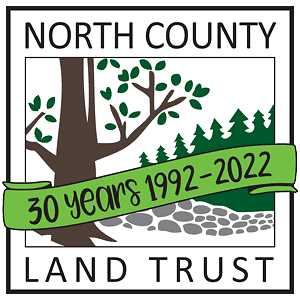By Mike Leonard of North Quabbin Forestry (NCLT’s consulting forester)
The 175 acre Rome Conservation Area is located along the northwestern corner of the City of Gardner. This property abuts a new residential subdivision but also abuts other conservation land owned by the city. The majority of the forest is about 80 years old and consists of mostly lower grade hemlock, white pine, and red maple with some red spruce and scattered balsam fir, cherry, ash, yellow birch, beech, and red oak. The mix of coniferous trees is very interesting. Red spruce and balsam fir are more often found in northern New England and in higher elevations in the Berkshires. Unfortunately this forest suffered a highgrade cutting about 30 years ago. Highgrading, also called liquidation cutting, is the cutting of the best timber without cutting any of the lower quality trees. That highgrade removed almost all of the high value white pine which resulted in a degraded forest.
In 2017, I was contracted to develop a Forest Cutting Plan based on the Rome Conservation Area’s Forest Stewardship Plan. The purpose of the timber harvest was to upgrade the overall quality of the forest by reducing the amount of low grade timber. The total area that was marked to be thinned was 85 acres out of the 175 acres. The other areas consisted of wetlands or were inaccessible for timber harvesting machinery. The trees to be cut in the harvest area were marked with blue paint at chest height and on the stump. Trees marked with a slash were designated as sawlogs while trees marked with a spot were cordwood or pulpwood.
This was a mechanized operation which utilized a feller-buncher timber harvesting machine and a grapple skidder. The feller-buncher cut and piled the marked timber and the grapple skidder pulled the piles of cut trees (referred to as “hitches”) to the landing area where they were processed into sawlogs, firewood, and wood chips. The sawlogs were sold to regional sawmills in New England while the cordwood was sold to local firewood dealers, and the wood chips were sold to biomass power plants and to a wood pellet manufacturer helping to maintain many jobs right up the wood supply chain and provide a source of clean renewable energy. The amount of unsightly slash was minimized while there is enough coarse woody debris left to comply with the biomass retention standards for nutrient recycling. The thinning removed about 1/4 – 1/3 of the basal area (which is a measure of the density of a forest) and consisted of the lower quality hemlock, white pine, spruce and hardwood sawtimber, pulpwood, and cordwood trees that had poor stem form and/or insufficient live crowns that would not support good diameter growth. The trees that were retained were the higher quality white pine, hemlock and hardwood sawtimber and pole timber with better stem form and superior live crowns which will support good diameter growth. In addition, there were snags (dead trees) and cavity trees retained for wildlife. Some marked timber was not cut because the frozen ground thawed which made it unstable to support the timber harvesting machinery. We hope to complete the job 100% when the ground is dry enough to finish the job.
In another 10-15 years, another improvement cutting will be recommended to continue to upgrade the overall quality of this forest. The goal will be to: continue to increase tree growth on the more desirable trees; continue to improve wildlife habitat for a variety of bird and animal species; and to improve the scenic beauty of the area for hikers.
